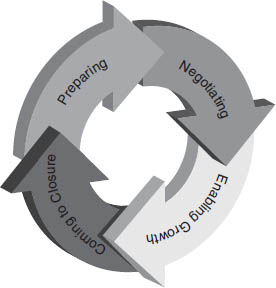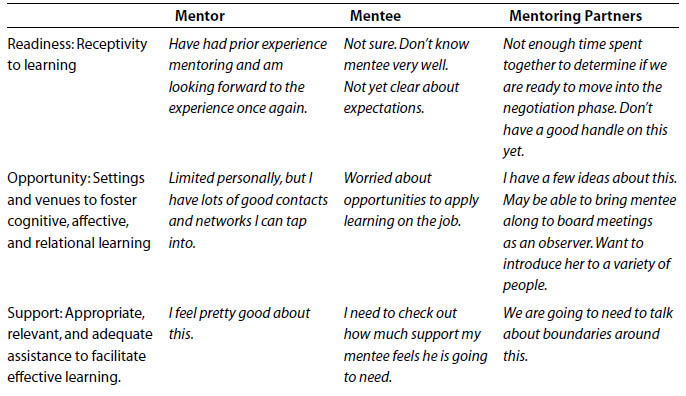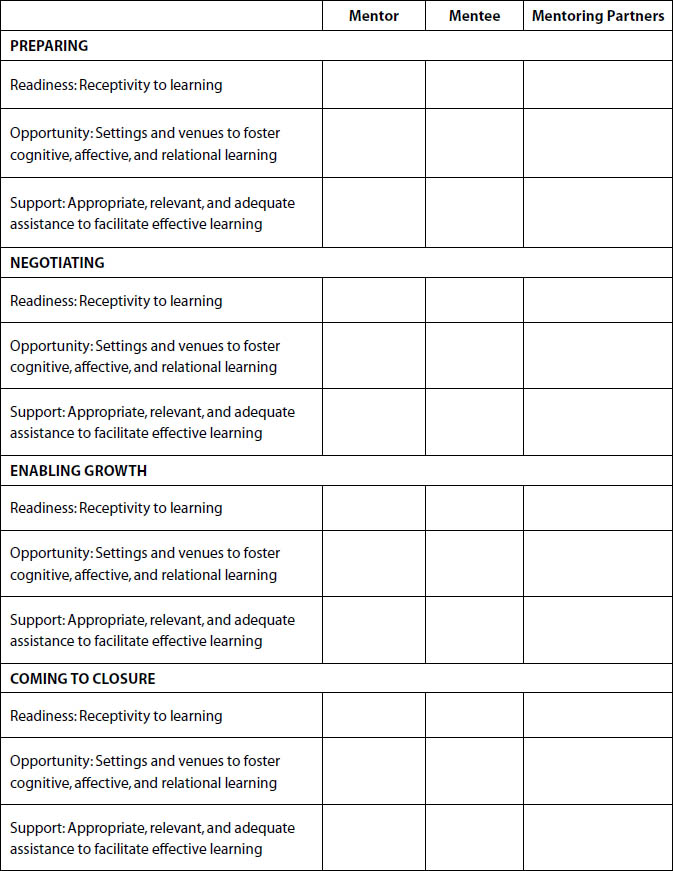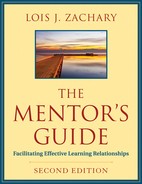PART TWO
The Predictable Phases of Mentoring
THE CHAPTERS IN PART ONE explored mentoring in the context of who we are. In Part Two, we shift our focus to what we do: the work of mentoring and the predictable phases that guide this work.
For new mentors and those who have mentored without formal guidance, the knowledge that mentoring relationships have a predictable structure can be liberating:
Phase 1: Preparing (getting ready)
Phase 2: Negotiating (establishing agreements)
Phase 3: Enabling Growth (facilitating learning)
Phase 4: Coming to Closure (looking back, moving forward)
Although these phases are predictable and naturally build on one another, they are not linear. In fact, we generally portray them as a cycle, as shown in the figure below. The phases are less bound by time definition and psychological milestones; rather, you will know where you are, where you are going, and where you need to be because of the behaviors required to move through each of the stages. With one mentee, for example, you may cycle through the phases smoothly; with another, you may find that although you are actively engaged in one phase, you need to revisit the previous phase. Simply being aware of these phases—and knowing that they are indeed predictable—provides significant signposts for both mentor and mentee.

Movement through the four phases follows a fluid yet foreseeable cycle and usually with some overlap between them. For example, during the enabling growth phase, when mentoring partners are most likely to face potential obstacles, they may need to renegotiate aspects of their mentoring partnership agreement in order to move forward and maintain the relationship. Sometimes mentoring partners move into the coming to closure stage prematurely and find that they have unfinished goals to complete before they bring the relationship to a close.
Phase One: Preparing
The preparing phase is a discovery process. Because every mentoring relationship is unique, you and your mentoring partner must take this time to set the tone for the relationship by engaging in conversation, getting to know each another, and understanding each other’s contexts.
Clarity about both expectation and role is essential for establishing a productive mentoring relationship. You can also explore your personal motivation and readiness to mentor this individual. Assess your mentoring skills to identify areas for your own learning and development.
Phase Two: Negotiating
Negotiating is the business phase of the relationship—the time when mentoring partners come to agreement on learning goals and define the content and process of the relationship. Although you will establish goals and create a work plan during this phase, negotiating the relationship is not as simple as drawing up an agreement.
The heart of the negotiating phase has to do with creating a shared understanding about assumptions, expectations, goals, and needs. It involves talking about some of the soft issues in a relationship—important topics like ground rules, confidentiality, boundaries, and hot buttons, which often are left out of mentoring conversations because the partners find these issues difficult to talk about. Establishing boundaries in this way lays a solid foundation for building trust.
Another way to describe the negotiating phase is “the detail phase.” This is when the details of when and how to meet, responsibilities, criteria for success, accountability, and bringing the relationship to closure are mutually articulated.
Phase Three: Enabling Growth
The enabling growth phase is the work phase of the learning relationship, when most of the contact between mentoring partners takes place. Although it offers the greatest opportunity for nurturing learning and development, the mentoring partners are also most vulnerable to the obstacles that can contribute to derailment of the relationship—even when obstacles and goals have been clearly articulated. Inevitably each relationship must find its own path and maintain a sufficient level of trust to develop a quality mentoring relationship and promote learning.
The mentor’s role during this phase is to facilitate learning by establishing and maintaining an open and affirming learning climate and providing thoughtful, timely, candid, and constructive feedback. Both you and your mentee will monitor the learning process and learning progress to ensure that the mentee’s learning goals are being met.
Phase Four: Coming to Closure
Coming to closure is much more than simply marking the end of the mentoring relationship; it is an opportunity for both partners to recognize and celebrate what they have learned. This evolutionary process has a beginning (establishing closure protocols when setting up a mentoring agreement), a middle (anticipating and addressing obstacles along the way), and an end (ensuring that there has been positive learning, no matter what the circumstances). All three components are necessary for satisfactory closure.
Successful closure encompasses evaluating, acknowledging, and celebrating achievement of learning outcomes. Both mentors and mentees can benefit from closure. It is an opportunity to harvest the learning and apply what you have learned to other relationships and situations.
THE ROS MODEL: READINESS, OPPORTUNITY, SUPPORT
The four-phase model is a map you can use to keep your mentoring relationship on a steady course and to see where you are and where you need to be as you follow the unique twists and turns of each mentoring experience. As you will soon discover, every phase of the mentoring relationship presents specific learning challenges. The combination of three primary elements—readiness, opportunity, and support (the ROS model)—facilitates successful movement through each phase.
Readiness relates to receptivity and openness to the learning experience. It addresses the issue of preparedness for every phase. Opportunity refers not only to the venues, settings, and situations available for fostering learning, but also to the quality of that opportunity. Support pertains to relevant and adequate assistance to promote effective learning.
When a third party determines the mentoring pairing, as often happens in a formal mentoring program, readiness may be the last element of the ROS model to fall into place for the mentoring partners. There may be ample opportunity to foster learning, and the mentor may be able to provide adequate support, but the mentor or the mentee (or sometimes both) may not be open to this particular relationship at this time.
Many reasons can account for lack of readiness—for example, lack of perceived need, a belief that the need for mentoring is a “weakness,” or that the teachable moment has not yet arrived or has already passed. Charging headlong into a mentoring partnership when readiness has not yet been achieved spells disaster. Situations like this can be overcome by paying attention to the conversational possibilities of the preparing phase, allowing adequate time for both parties to come to a shared understanding of the purposes of the relationship before moving into the negotiating phase.
The framework of the ROS tool can help mentors and their mentees analyze which elements are in place and which are missing before moving to the next phase of the mentoring relationship. Gauging the presence or absence of these primary elements helps keep the mentoring relationship on track by identifying possible stumbling blocks. For example, before moving into the enabling phase, you and your mentee must make sure that you have completed the necessary groundwork, have some ground rules in place, are clear about the purpose of the relationship, have determined the opportunities for enabling the relationship, and understand the kind of support that is required.
You can use the ROS tool on the next page before moving to the next mentoring stage, or when the relationship seems out of kilter. This grid will help you identify strengths and weaknesses in the relationship and target areas for improvement.
The example below shows how one mentor used the ROS tool to determine that he and his mentoring partner were not yet ready to move into the negotiating phase of the relationship. Although he knew this was the situation, completing the grid helped him pinpoint some areas for discussion with his mentoring partner during their next conversation.
The knowledge that preparation, negotiating, enabling growth, and coming to closure are all necessary pieces of the mentoring puzzle will help you understand where you and your mentoring partner are and where you are heading. It will also alert you that you may have rushed through a phase, or skipped it, or need to return to do a little more work. It is this very opportunity to improvise in the moment that lifts mentoring into the realm of adult learning.


The chapters in Part Two guide you through each of the four phases. (The enabling growth phase, the most complex one, spans two chapters.) Chapters Four through Eight discuss the components of the particular phase and offer exercises and approaches you can use to make the most of your mentoring relationship. In Chapter Nine, we explore ways you can contribute to your own growth and development as a mentor and dig deeper into many of the topics presented in this book. It contains an annotated list of resources to further your learning.
